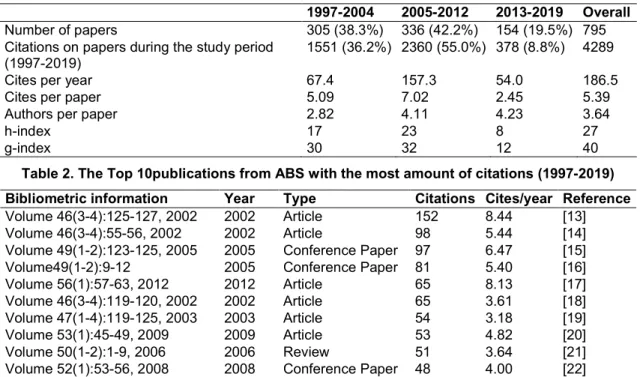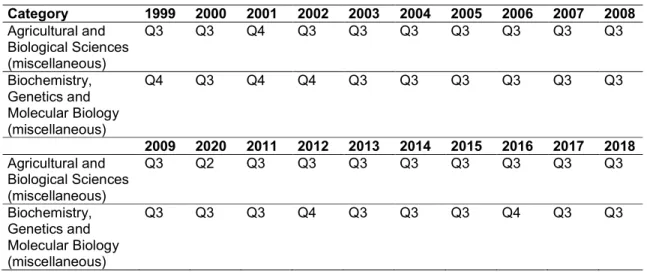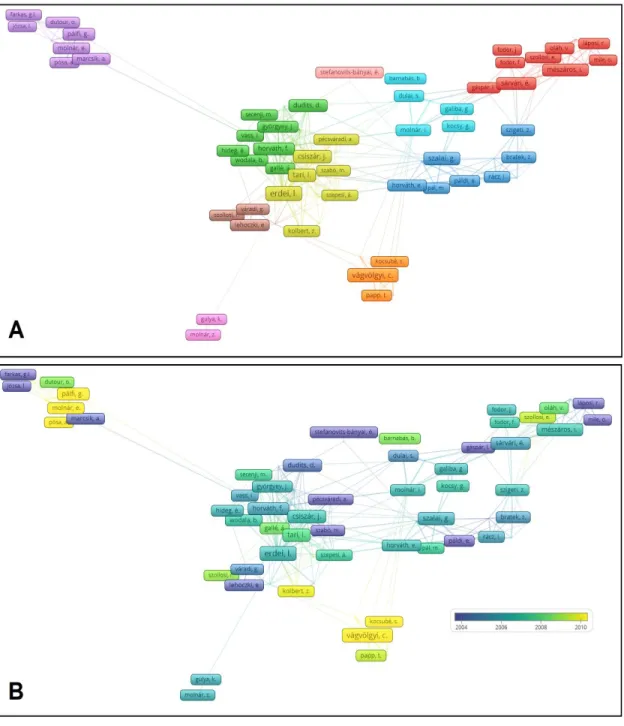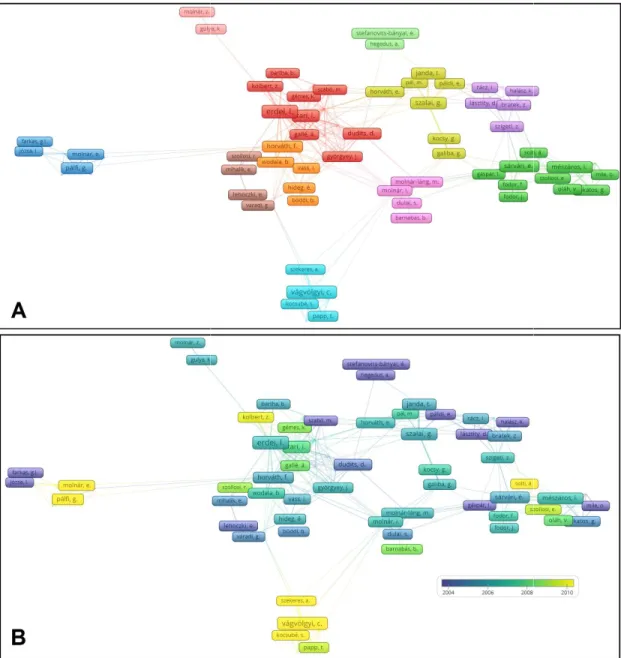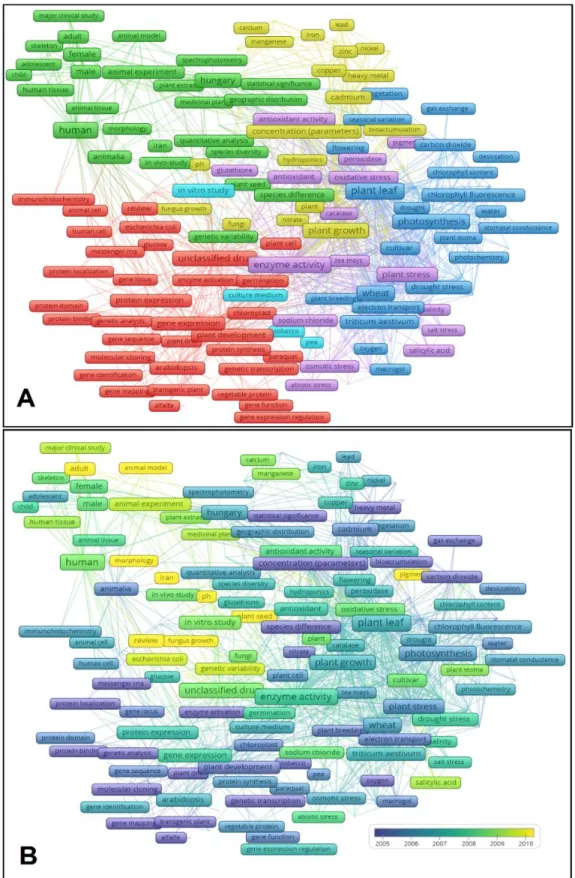_____________________________________________________________________________________________________
*Corresponding author: E-mail: mariopharma92@gmail.com;
(Past name:British Journal of Applied Science & Technology,PastISSN: 2231-0843,
NLM ID: 101664541)
Acta Biologica Szegediensis: A Bibliometric Analysis (1997-2019)
Mario Gajdacs1,2*
1Department of Pharmacodynamics and Biopharmacy, Faculty of Pharmacy, University of Szeged, Hungary.
2Institute of Medical Microbiology, Faculty of Medicine, Semmelweis University, Hungary.
Author’s contribution
Author MG designed the study, performed the statistical analysis, wrote the protocol and wrote the manuscript.
Article Information
DOI: 10.9734/CJAST/2020/v39i2330865 Editor(s):
(1) Dr. Orlando Manuel da Costa Gomes, Lisbon Accounting and Business School (ISCAL), Lisbon Polytechnic Institute, Portugal.
(2) Qing-Wen Wang, Shanghai University, China.
Reviewers:
(1)Renan Moritz V. R. Almeida, Universidade Federal do Rio de Janeiro, Brazil.
(2)Sibhatu Gebrehiwot, Raya University, Ethiopia.
(3)Hetaben Maulikkumar Kachhiya, CVM University, India.
(4)Madhumita Barooah, Assam Agriculture University, India.
Complete Peer review History:http://www.sdiarticle4.com/review-history/60016
Received 08 June 2020 Accepted 14 August 2020 Published 18 August 2020
ABSTRACT
Aims: Scientometrics is a field concerned with the qualitative and quantitative analysis of scientific publications, which are frequently used in the field of library and information sciences. The aim of this study to present a general overview of the journal Acta Biologica Szegediensis (ABS) from 1997 to 2019 (a 23-year period) using bibliometric indicators.
Methodology: The data analysed in this study was extracted from the Scopus database. The information was exported in RIS file format to the Harzing’s Publish or Perish 7.22 and VOSviewer 1.6.15 for data analysis. Clusters and co-occurrence networks of the authors and keywords of the published documents were generated.
Results: The number of documents published in ABS during the study period was n=795, the most frequently published document type was „original article” (n=534, 67.2%). Articles published between 1997 and 2019 were cited 4289 times overall, averaging in 5.39 citations per paper and 186.5 cites/year. The average number of authors per paper increased consistently throughout the years (from 2.82 to 4.23).
Review Article
Conclusion: ABS is in a unique position; while it is primarily a journal of the University of Szeged, it has received increasing attention from an international scientific audience, both from molecular and supra-individual biologists, pharmacists and other medical scientists. The submission of additional articles from a wider audience would definetly strengthen the international reach and scientific impact of the journal.
Keywords: Acta Biologica Szegediensis; bibliometric analysis; biological science; citation; cluster analysis.
ABBREVIATIONS
ABS : Acta Biologica Szegediensis AMIH : Acta Microbiologica et
Immunologica Hungarica APH : Acta Pharmaceutica Hungarica IF : impact factor
ISSN : International Standard Serial Number
Q : quartile
RIS : Research Information Systems, Incorporated
USzeged : University of Szeged 1. INTRODUCTION
Bibliometric sciences are an area of data science that has received substantial attention in the recent years [1]. The discipline of bibliometrics is concerned with the use of statistical methods to analyse various publications (including books, publication and web pages) [2]. Two relevant sub-specialties of bibliometrics include content analysis (the study of documents and communication artifacts, which may include texts, pictures, audio or video) and scientometics, which is concerned with the qualitative and quantitative analysis of scientific publications [3]. Scientometrics are frequently used in the field of library and information science [4]. In academia, one of the main roles of bibliometrics and scientometrics is to evaluate the impact of journals, institutions, study groups or individual scientists [5]. This may be important for a plethora of reasons; e.g., institutional libraries often evaluate such journal parameters before including journals in their collection or their ‘approved’ list [6]. Furthermore, when before the submission of a manuscript, authors also assess commonly known bibliometric parameters (e.g., impact factor, Cite Score, Hirsch-index or h-index, Egghe or g-index, number of publications per year, ratio of national/international papers) of a journal, in addition to its scope and other aspects [7].
Another important indicator for any scientific
journal is the inclusion to major databases and indexing services (such as Web of Science, Scopus, PubMed/MEDLINE, EMBASE and so on), which will help to increase the reputation of a journal, allowing for a wider audience [8].
Acta Biologica Szegediensis (ABS; pISSN 1588- 385X; eISSN 1588-4082), is an international peer-reviewed, open access journal, published bi-annually by the University of Szeged (USzeged) [9]. The journal is devoted to the publication of manuscripts from all fields of biology and biomedical sciences, including, but not limited to: anatomy, embryology and histology, anthropology, biochemistry, biophysics, biotechnology, botany and plant physiology, all areas of clinical sciences, conservation biology, ecology, genetics, microbiology, molecular biology, neurosciences, paleontology, pharmacology, physiology/
pathophysiology and zoology. The journal publishes experimental and theoretical papers, reviews, short communications and the descriptions of new methodologies. Additionally, supplement issues related to conferences organized by the Institute of Biology are also published [9]. ABS is in a unique position; while it is primarily a journal of the University of Szeged, it has received increasing attention from an international scientific audience, both from molecular and supra-individual biologists, pharmacists and other medical scientists; in addition, the journal is listed by several international content indexing services and was continuously on the path of receiving an IF (although this has not happened thus far) [9]. On the other hand, the number of submission have decreased in the last several years. Therefore, this journal is an ideal target for bibliometric assessment to characterize the concurrent changes affecting this journal. The aim of the present study is to give a general bibliometric overview of ABS, corresponding to a 23-year period (1997-2019), starting from the time period during which the journal is listed by international content indexing services.
2. MATERIALS AND METHODS
The data analyzed in this study – corresponding to the time period between 1997 and 2019 – was extracted from the Scopus database on the 15th of June 2020. Some of the data (e.g., quartile rankings and percentage of collaborative publications) was only available till 2018. The information was exported in RIS (Research Information Systems, Incorporated) file format to the Harzing’s Publish or Perish 7.22 (Tarma Software Research Ltd., Melbourne, Australia) and VOSviewer 1.6.15 (Leiden University, Leiden, The Netherlands) software for data analysis [10-12]. The former software was used for the quantitative assessment of publication metrics, while the latter was used to generate author collaboration and word co-occurrence networks from the recovered data. During co- authorship and co-occurrence analyses, both the full and fractional counting methods were used to detect any disparities in the collected data [8].
Full counting means that each co-authorship and co-occurrence link has the same weight; while during fractional counting, the weight of a link is fractionalized [12].
3. RESULTS AND DISCUSSION
The total number of documents published in ABS during the study period was n=795; the number of published papers was consistent in the first
two sub-periods studied (1997-2004 and 2005- 2012), while a substantial drop (by 49.6-54.2%) was seen in the most recent period (2013-2019) (Table 1). The most frequently published document type (based on the indexing data provided by Scopus) was „original article”
(n=534, 67.2%), followed by „conference paper”
(n=148, 6.10%; first occurrence in 2005), „note”
(n=60, 7.5%; first occurrence in 2002), „review”
(n=46, 5.8%; first occurrence in 2000), „editorial”
(n=5, 0.6%; first occurrence in 2002) and „errata”
(n=2, 0.3%; first occurrence in 2002). The average number of authors per paper increased consistently throughout the years (from 2.82 to 4.23) (Table 1). Articles published in ABS
between 1997 and 2019 were cited 4289 times overall, averaging 5.39 citations per paper
and 186.5 cites/year, with the majority of
citations on articles published in the period between 2005-2012 (Table 1). The
average ratio of self-citations was 15.2% (range:
0-95.2%, lowest in 2000, highest in 2018). The papers with high citation rates (n=31 papers, defined as 25 or more cites) correspond to
33.9% of total citations (72.7 cites/year year, 46.9 cites/paper) for ABS (articles listed in
Table 2).
The journal is associated with and measured in two scientific subject categories, namely Agricultural and Biological Sciences (miscellaneous) and Biochemistry, Genetics and Table 1. General bibliometric characteristics of ABS between 1997-2019
1997-2004 2005-2012 2013-2019 Overall
Number of papers 305 (38.3%) 336 (42.2%) 154 (19.5%) 795
Citations on papers during the study period (1997-2019)
1551 (36.2%) 2360 (55.0%) 378 (8.8%) 4289
Cites per year 67.4 157.3 54.0 186.5
Cites per paper 5.09 7.02 2.45 5.39
Authors per paper 2.82 4.11 4.23 3.64
h-index 17 23 8 27
g-index 30 32 12 40
Table 2. The Top 10publications from ABS with the most amount of citations (1997-2019) Bibliometric information Year Type Citations Cites/year Reference
Volume 46(3-4):125-127, 2002 2002 Article 152 8.44 [13]
Volume 46(3-4):55-56, 2002 2002 Article 98 5.44 [14]
Volume 49(1-2):123-125, 2005 2005 Conference Paper 97 6.47 [15]
Volume49(1-2):9-12 2005 Conference Paper 81 5.40 [16]
Volume 56(1):57-63, 2012 2012 Article 65 8.13 [17]
Volume 46(3-4):119-120, 2002 2002 Article 65 3.61 [18]
Volume 47(1-4):119-125, 2003 2003 Article 54 3.18 [19]
Volume 53(1):45-49, 2009 2009 Article 53 4.82 [20]
Volume 50(1-2):1-9, 2006 2006 Review 51 3.64 [21]
Volume 52(1):53-56, 2008 2008 Conference Paper 48 4.00 [22]
Table 3. Quartile ranking of ABS between 1999-2018
Category 1999 2000 2001 2002 2003 2004 2005 2006 2007 2008 Agricultural and
Biological Sciences (miscellaneous)
Q3 Q3 Q4 Q3 Q3 Q3 Q3 Q3 Q3 Q3
Biochemistry, Genetics and Molecular Biology (miscellaneous)
Q4 Q3 Q4 Q4 Q3 Q3 Q3 Q3 Q3 Q3
2009 2020 2011 2012 2013 2014 2015 2016 2017 2018 Agricultural and
Biological Sciences (miscellaneous)
Q3 Q2 Q3 Q3 Q3 Q3 Q3 Q3 Q3 Q3
Biochemistry, Genetics and Molecular Biology (miscellaneous)
Q3 Q3 Q3 Q4 Q3 Q3 Q3 Q4 Q3 Q3
Table 4. Articles published in international collaboration in APH between 1999-2018
1999 2000 2001 2002 2003 2004 2005 2006 2007 2008 Percentage 0% 0% 0% 0% 9.5% 6.3% 9.4% 24.0% 11.1% 12.7%
2009 2020 2011 2012 2013 2014 2015 2016 2017 2018 26.9% 21.7% 6.9% 27.3% 20.0% 19.2% 10.9% 13.7% 8.3% 11.8%
Molecular Biology (miscellaneous). Based on the international impact of the papers published, the quartile ranking of ABS ranged between the second (Q2) and fourth (Q4) quartile in the former, while between the third (Q3) and fourth (Q4) quartile in the latter category (Table 3).
Scientific publications originating from international scientific collaborations usually enhance the quality of impact of the published papers. The rate of collaborative publications (here defined as articles with authors from more than one country) is an important indicator for journals of both local and international relevance;
thus, the ratio of collaborative publications in ABS was also assessed, which is presented in Table 4. The highest number of articles published in collaboration was in 2006 and 2009, respectively (24.0% and 26.9%).
To establish the network of strong collaborators and the profile of ABS in the study period in more depth, the authors and the words present in the titles and abstracts of the published documents were analyzed by VOSviewer with the aim of generating clusters and co-occurrence networks.
Together with the connecting lines, the different colors and color shades of Figs. 1-2. indicate the quantitative and temporal relationships of the co- author collaboration networks, while Figs. 3-4.
represent the quantitative and temporal relationships of keyword co-occurrence
networks. Figs. 1 and 3. utilized the full counting method, while Figs. 2 and 4. used the fractional counting method. Although the arrangement of the clusters varied somewhat between the two counting methods, the clusters themselves did not change, indicating the adequacy of the collected data. Out of 1642 authors, 94 met the threshold to become „nodes” in the generated network (i.e., had at least one co-authored paper with another author qualifying to be a „node”), and 74 was enrolled in the generation of clusters of association (Figs. 1-2.). Overall, 6781 keywords were identified by the VOSviewer, from which 242 met the threshold to become „nodes”
and was included in the generation of the co- occurrence network. Figs. 3-4. reflect on the changing trends in the topics covered by the journal, in the respective study period.
The number of citations has decreased substantially during the time period of 2013-2019 (see Table 1.), despite an increase in the ration of articles published in international collaboration (see Table 4), even though international collaboration is recognized in the literature as the way to increase a journal’s scientific impact;
several factors may have contributed to this phenomenon: i) firstly, the number of submission have drastically decreased in this time period, which may (partly) be due to changes in the PhD requirements in Hungarian Universities, where
most doctoral schools sequestered papers possessing IFs, ii) the main topics covered by accepted manuscripts in the respective time periods have also changed substantially; the most cited articles throughout the study period were concerning plant physiology/plant biology
(and in the first and second parts of the study period, these articles were accepted in high numbers), while in the last period (2013-2019), the topics covered by the accepted papers were associated more with microbiological studies and animal experiments.
Fig. 1. Overlay visualization of co-author collaboration networks during the full counting method, based on content (A) and temporal analysis (B)
Fig. 2. Overlay visualization of co
method, based on content (A) and temporal anal Two Hungarian journals with a similar research
profile were assessed with bibliometric methods:
Acta Pharmaceutica Hungarica (APH)
Acta Microbiologica et Immunologica Hungarica (AMIH) [8]. While both have a similar profile to ABS in terms of ranking and scope (Q3 indexed in Scopus), AMIH also possesses an IF
~ 1. During these analyses, a similar drop in the number of citations were seen in both APH and AMIH, while a decrease in the number of published articles (a reduction of ~ 50% in the last 15 years) was only shown in APH. The ratio
Fig. 2. Overlay visualization of co-author collaboration networks during the fractional counting method, based on content (A) and temporal analysis (B)
Two Hungarian journals with a similar research profile were assessed with bibliometric methods:
Acta Pharmaceutica Hungarica (APH) [4] and Acta Microbiologica et Immunologica Hungarica (AMIH) [8]. While both have a similar profile to ABS in terms of ranking and scope (Q3-Q4, indexed in Scopus), AMIH also possesses an IF
~ 1. During these analyses, a similar drop in the ions were seen in both APH and AMIH, while a decrease in the number of published articles (a reduction of ~ 50% in the last 15 years) was only shown in APH. The ratio
of international collaboration was ranging between 9.68%-25.64% for AMIH and 0
APH, respectively. Interestingly, ABS had the paper with the highest number of citations (n=152), while the highest-cited paper in AMIH only had n=120 (even though this journal has an IF) [4,8]. The topics covered in AMIH remained consistent throughout the study (2005 while in APH (1965-2018), a similar evolution of the research topics covered by the journal was observed, which has provide a contemporary overview of the pharmaceutical sciences [4,8].
author collaboration networks during the fractional counting
of international collaboration was ranging 25.64% for AMIH and 0-16.7% in PH, respectively. Interestingly, ABS had the paper with the highest number of citations cited paper in AMIH only had n=120 (even though this journal has an IF) [4,8]. The topics covered in AMIH remained study (2005-2018), 2018), a similar evolution of the research topics covered by the journal was observed, which has provide a contemporary overview of the pharmaceutical sciences [4,8].
Fig. 3. Keyword co-occurrence network from documents published in ABS the full counting method
Fig. 4. Keyword co-occurrence network from documents published in ABS the fractional counting method
4. CONCLUSION
The present study represents a qualitative and quantitative bibliometric analysis of the leading
trends occurring in Acta Biologica Szegediensis between 1997 and 2019, using the Scopus database for data collection and specialized software for data analysis. To assess ABS from
more viewpoints, the study also involved the analysis of author and keyword co-occurrence networks. ABS is a journal which manages to reach a relatively wide audience of the Hungarian and International scientific community interested in its contents. The submission of additional articles of high significance from a wider audience would definetly strengthen the international reach and scientific impact of ABS and may subsequently lead to the journal receiving an impact factor.
FUNDING STATEMENT
Márió Gajdács (M.G.) was supported by the János Bolyai Research Scholarship of the Hungarian Academy of Sciences. M.G. would also like to acknowledge the support of the ESCMID’s “30 under 30” Award.
DATA AVAILABILITY
All data generated during the study is presented in this paper.
COMPETING INTERESTS
Author has declared that no competing interests exist.
REFERENCES
1. Jain S, Basavaraj P, Singla A, Singh K, Kundu H, Vashishtha V, Pandita V, Malhi V. Bibliometric analysis of journal of clinical and diagnostic research (dentistry section;
2007-2014). J Clin Diagn Res.
2015;9:ZC47-51.
2. Corrales IE, Reyes JJ, Fornaris Y.
Bibliometric analysis of the Journal of Oral Research. Period 2012-2015. J Oral Res.
2016;5:188-193.
3. Baladi ZH, Umedani, LV. Pakistan Journal of Medical sciences: A bibliometric assessment 2001-2010. Pak. J. Med. Sci.
2017;33:714–719.
4. Gajdács M. A bibliometric analysis of Acta Pharmaceutica Hungarica (1965-2018).
Acta Pharm. Hung. 2019;89:19-25.
5. Restrepo G, Willett P. The Journal of Mathematical Chemistry: a bibliometric profile J. Math. Chem. 2017;55(8):1589–
1596.
6. Cooper DI. Bibliometrics basics. J. Med.
Libr. Assoc. 2015;103:217–218.
7. Alonso S, Cabrerizo FJ, Herrera-Viedma E, Herrera F. h-index: a review focused in
its variants, computation and standardization for different scientific fields.
J Informet 2009;3:273–289.
8. Gajdács M. A bibliometric profile of Acta Microbiologica et Immunologica Hungarica:
2005-2018. Int. J. Clin. Med. Microbiol.
2019;4:139.
9. Acta Biologica Szegediensis: About the journal (2020)
Available:http://abs.bibl.u-
szeged.hu/index.php/abs/about Accessed on: 15th of June, 2020.
10. Harzing’s Publish or Perish; 2020.
Available:https://harzing.com/resources/pu blish-or-perish Accessed on: 15th of June, 2020.
11. VOSviewer; 2020.
Available:https://www.vosviewer.com/
Accessed on: 15th of June, 2020.
12. Krauskopf K. A bibiliometric analysis of the Journal of Infection and Public Health:
2008–2016. J. Infect. Pub. Health.
2016;11:224-229.
13. Szöllősi R, Szöllősi Varga I. Total
antioxidant power in some species of Labiatae (Adaptation of FRAP
method). Acta Biol. Szeged. 2002;46:125- 127.
14. Tari I, Csiszár J, Szalai G, Horváth F, Pécsváradi A, Kiss G, Szepesi Á, Szabó M, Erdei L. Acclimation of tomato plants to salinity stress after a salicylic acid pre- treatment. Acta Biol. Szeged. 2002;46:55- 56.
15. Szepesi Á, Csiszár J, Bajkán S, Gémes K, Horváth F, Erdei L, Deér AK, Simon ML, Tari I. Role of salicylic acid pre-treatment on the acclimation of tomato plants to salt- and osmotic stress. Acta Biol. Szeged.
2005;49:123-125.
16. Bartha B, Kolbert Z, Erdei L. Nitric oxide production induced by heavy metals in Brassica juncea L. Czern. and Pisum sativum L. Acta Biol. Szeged. 2005;49:9- 12.
17. Habibi G. Exogenous salicylic acid alleviates oxidative damage of barley plants under drought stress. Acta Biol.
Szeged. 2012;56:57-63.
18. Pál M, Szalai G, Horváth E, Janda T, Páldi E. Effect of salicylic acid during heavy metal stress. Acta Biol. Szeged.
2002;46:119-120.
19. Lugasi A, Hóvári J, Sági KV, Bíró L. The role of antioxidant phytonutrients in the prevention of diseases. Acta Biol. Szeged.
2003;47:119-125.
20. Asha DS, Ganjewala D. Antimicrobial activity of acorus calamus (L.) rhizome and leaf extract. Acta Biol. Szeged.
2009;53:45-49.
21. Shao HB, Chu LY, Zhao CX, Guo QJ, Liu XA, Ribaut JM. Plant gene regulatory
network system under abiotic stress. Acta Biol. Szeged. 2006;50:1-9.
22. Fehér A. The initiation phase of somatic embryogenesis: What we know and what we don't. Acta Biol. Szeged. 2008;52:53- 56.
_________________________________________________________________________________
© 2020 Gajdacs; This is an Open Access article distributed under the terms of the Creative Commons Attribution License (http://creativecommons.org/licenses/by/4.0), which permits unrestricted use, distribution, and reproduction in any medium, provided the original work is properly cited.
Peer-review history:
The peer review history for this paper can be accessed here:
http://www.sdiarticle4.com/review-history/60016
